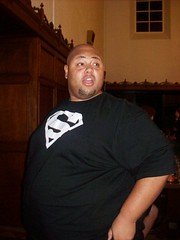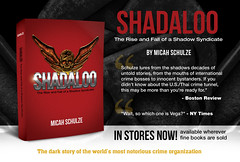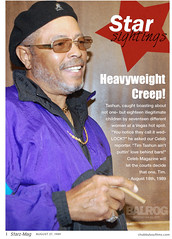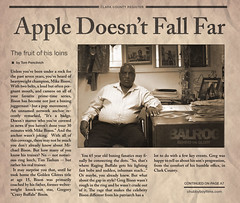The man who crafted the story of Balrog: Behind the Glory, Brett D. Bayonne was responsible for drafting and revising the screenplay which served as the foundation of the film. He’s been playing fighting games since the SFII era, and currently plays SSF4AE and MvC3 avidly.
Maj: What are your general preferences in fighting games?
Brett: If you’re asking what fighting games I enjoy playing then the list is pretty exhaustive. I was an arcade rat from ’91 to at least ’98, and I’ve had sordid love affairs with more than one fighting game franchise. I’m pretty sure I owe child support payments to Virtua Fighter, Soul Calibur, Gulity Gear, the Versus series, and especially Street Fighter.

But if you’re talking about the features that I look for in fighting games, then I’d have to say:
A) Interesting, vibrant characters
B) Gameplay with depth, and
C) Good balance between characters’ power
What drew me to fighting games in the first place were the characters. They were the focal points of my admiration, empathy and awe, and that hasn’t changed to this day. I came for the awesome characters and stayed for the deep, challenging and rewarding gameplay.
Maj: What’s your favorite thing about Street Fighter?
Brett: In my opinion, no other game genre has the amount of depth, complexity and sophistication that fighting games have. Their learning curves are pretty high, but those curves are undoubtedly a direct cause of the incredible sense of accomplishment and reward that one experiences upon noticing their own improvement.
Fighting games challenge their players, and as someone who deeply values challenges and opportunities for self improvement, I was hooked on the genre as soon as I laid hands on a six button layout. Street Fighter will always hold a special place in my heart because it was the first game to ask me “You can do better than that, can’t you?”
Maj: How did you come up with the premise for Balrog: Behind the Glory?
Brett: My friends and I have been Street Fighter fans for a long time, so we’re pretty well versed in the game’s storyline – as published by Capcom.
 The tidbit that always tickled us the most was the fact that, in official canon, Boxer claimed ownership over Shadaloo once Dictator was out of the picture, and subsequently ran it into the ground.
The tidbit that always tickled us the most was the fact that, in official canon, Boxer claimed ownership over Shadaloo once Dictator was out of the picture, and subsequently ran it into the ground.
The mere idea of one of the game’s bosses falling so far was pretty damn funny to us. Boxer ruining his own life became an inside joke in our circle, so tons of bits and ideas were generated over a few years. Once the opportunity to make a Street Fighter themed movie came along, I knew I already had the perfect premise in my back pocket.
Maj: Why did you take the documentary approach?
Brett: Boxer is a ridiculous character. He’s a poorly veiled parody of Mike Tyson (SPOILER!), and it’s hard to take him seriously. Thus, the funniest possible approach one could take when dealing with Boxer would be to treat him as seriously as possible, and that’s exactly what a documentary attempts to do.
Most “Behind the ____” docs treat their subject matter with reverence and solemnity, and the thought of dealing with Boxer in that way cracks me up. He’s practically a cartoon, so it’s fun to treat him like a feeling, caring person.
Maj: In telling this story, what was the most important aspect to you?
Brett: Two things were very important to us during the making of this film. The first was making sure to embrace the canon that’s already been established. When it comes to fiction, it’s exceedingly difficult to make something seem or feel real when aspects of that fiction contradict one another. If I’m making up a story with my friend and I say, “Once, there was a magic castle,” and then my storytelling partner says “Actually, it wasn’t a castle. It was a rocket ship,” then the reality of that fiction is shattered for the listener.
Sure, maybe the story would end up better if it was about a rocket ship, but once a magic castle is mentioned, it’s established. And once it’s established, it’s canon in the minds of the listener. This is how we treated the already established information about Boxer.
Some of it we loved, some it we didn’t, but we made sure to embrace all of it. Rather than try to rewrite what existed, we instead attempted to write around and build off of it. In essence we made it a rule to say “Yes, and…” to the Boxer canon, no matter how ridiculous it was.
The other thing we made sure to do was to adhere to the solemn tone of the film. If something is already as ridiculous as Boxer’s character, the funniest thing you can do is treat it with deadly seriousness. We imagined Boxer’s life as a tragedy because we believed that making someone sympathize with a man with that haircut is the funniest thing we could possibly accomplish.
Maj: What has been the best part about getting to work on a Street Fighter movie?
Brett: The best part about working on a Street Fighter movie is getting to working on a Street Fighter movie. The characters in the Street Fighter universe mean a lot to us, and bringing them to life was a reward unto itself.

The first thing we filmed was the infamous “Poker Scene,” and walking into that terribly lit, brick laden room and seeing Claw, Dictator and Boxer in full costume was one of the most surreal experiences of my life. I took countless pictures of them just so I could remind myself later that I didn’t imagine it all. My childhood and my adult life briefly met, and I’m deeply thankful for that.
Also, working with my friends on this project was a dream come true. Making the film never felt like work. There was an atmosphere of play every step of the way.
Not only that, but I also got to meet and work with so many new, talented, kind, intelligent and passionate people. I feel incredibly lucky just to have had this opportunity.
Maj: What’s your overall background as a writer? How did you get into writing for film?
Brett: I’ve been writing since high school. I’ve always been into comic books, video games and movies, and high school was about the time that I realized that what I really liked about all of these things were the stories.
My ultimate dream was/is to write for a major comic book publisher, and I knew I’d need practice. So I vowed to write one comic book script a week, which I continue to do to this day. In college I wrote for and performed with various sketch comedy troupes. “B:BtG” is the first short film that I have full writing credits for, though. I currently write for Grab Games.
Maj: Do you have anything specific in mind for your next movie?
Brett: We’ve already got tons of ideas for future projects. The problem is that we’re pretty broke after pouring all of our savings into making “B:BtG.” We’re currently thinking of ways to raise money to continue making films. We’ve hoping that someone over at Capcom will see what we’ve put together and like it enough to sponsor the production of one more movie.
After all, there’s three more Shadaloo lords to visit and many more film styles besides documentary to play with. As far as I’m concerned, we’re just getting started.
Maj: If you had carte blanche to make a full-length Street Fighter movie in any way you wanted, what would be your take on it?
Brett: I think the key to doing a great feature-length Street Fighter film is to focus on character. Characters are the heart of every story and Street Fighter’s characters no different.
 Unfortunately, it seems that Hollywood feels that compelling character arcs are unnecessary when it comes to video game adaptations.
Unfortunately, it seems that Hollywood feels that compelling character arcs are unnecessary when it comes to video game adaptations.
If I had my way, though, I’d tell Ryu’s story. I’d chart his journey from being a mysterious orphan, to becoming a fledgling martial artist with burgeoning power of immense proportions while training at Gouken’s dojo with Ken, to traveling the world while battling in his first street fights, all the way to his final battle against the King of Muay Thai.
My rules would be to take it slow, treat it real and use the canon that’s already been established. Now that I think about it, I’d pretty much use the same methods we used in “B:BtG.”
Brett D. Bayonne is an aspiring author, comedian, and stream commentator (someone just needs to hand him a live mic). He is the main writer of the Chubby Boy Films crew, and often plays SSF4AE and MvC3 online under the gamertag ShaperofStories.
Thanks to Brett and Chubby Boy Productions for providing photos and official BBTG promo images for me to include in the article.